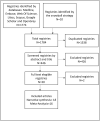Effect of PTPN22, FAS/FASL, IL2RA and CTLA4 genetic polymorphisms on the risk of developing alopecia areata: A systematic review of the literature and meta-analysis
- PMID: 34735462
- PMCID: PMC8568157
- DOI: 10.1371/journal.pone.0258499
Effect of PTPN22, FAS/FASL, IL2RA and CTLA4 genetic polymorphisms on the risk of developing alopecia areata: A systematic review of the literature and meta-analysis
Abstract
Objectives: Genetic association studies on alopecia areata (AA) performed in various populations have shown heterogeneous results. The aim of the current review was to synthesize the results of said studies to estimate the impact of FAS, FASL, PTPN22, CTLA4 and IL2RA gene polymorphisms on AA susceptibility.
Design: A systematic literature search was conducted in the Medline, Web of Science, Scopus, EMBASE and LILACS databases. Studies published up to June 2020 were included. The results available in the grey literature including the Open Grey and Google Scholar databases were also used. The texts of potentially related studies were screened by individual reviewers. Evidence of publication bias was assessed using the Newcastle-Ottawa scale and the quality of evidence was assessed using the GRADE system. The quantitative synthesis was performed using the fixed effect model.
Results: Out of 1784 articles, we identified 18 relevant articles for the qualitative synthesis and 16 for the quantitative synthesis. In a study of rs2476601 polymorphism of PTPN22 gene, including 1292 cases and 1832 controls, a correlation was found with the risk of developing AA in the allelic model (OR1.49 [95% C:1.13-1.95]), the heterozygous codominant (OR1.44 [95% CI:1:19-1.76]) and dominant model (OR1.43 [95% CI:1.18-1.73]). No association was found between the presence of FASL, PTPN22, CTLA and IL2RA gene polymorphisms with AA susceptibility.
Conclusions: The results suggest that the T allele of the single nucleoid polymorphism (SNP) rs2476601 in PTPN22 gene is a risk factor for developing alopecia areata. However, more robust studies defining the ethnic background of the population of origin are required, so that the risk identified in the present study can be validated. Additionally, a greater number of studies is necessary to evaluate the role of the FAS, FASL, PTPN22, CTLA4 and IL2RA genetic variants, given the heterogenous results found in the literature.
Conflict of interest statement
The authors have declared that no competing interests exist.
Figures




Similar articles
-
Genetic variant association of PTPN22, CTLA4, IL2RA, as well as HLA frequencies in susceptibility to alopecia areata.Immunol Invest. 2018 Oct;47(7):666-679. doi: 10.1080/08820139.2018.1480032. Epub 2018 Jul 6. Immunol Invest. 2018. PMID: 29979892
-
The association between rs2476601 polymorphism in PTPN22 gene and risk of alopecia areata: A meta-analysis of case-control studies.Medicine (Baltimore). 2019 May;98(20):e15448. doi: 10.1097/MD.0000000000015448. Medicine (Baltimore). 2019. PMID: 31096440 Free PMC article.
-
Overlapping and Distinct FAS/FASLG Gene Polymorphisms in Alopecia Areata in an Iranian Population.Immunol Invest. 2020 Feb;49(1-2):204-214. doi: 10.1080/08820139.2019.1688827. Epub 2019 Nov 19. Immunol Invest. 2020. PMID: 31741398
-
The association of PTPN22 (rs2476601) and IL2RA (rs11594656) polymorphisms with T1D in Egyptian children.Hum Immunol. 2016 Aug;77(8):682-686. doi: 10.1016/j.humimm.2016.06.006. Epub 2016 Jun 8. Hum Immunol. 2016. PMID: 27288719
-
Association of CTLA-4 gene polymorphisms and alopecia areata: a systematic review and meta-analysis.Biomarkers. 2022 Jun;27(4):338-348. doi: 10.1080/1354750X.2022.2046855. Epub 2022 Mar 17. Biomarkers. 2022. PMID: 35254172
Cited by
-
Genetic Polymorphism of PTPN22 in Autoimmune Diseases: A Comprehensive Review.Medicina (Kaunas). 2022 Aug 2;58(8):1034. doi: 10.3390/medicina58081034. Medicina (Kaunas). 2022. PMID: 36013501 Free PMC article. Review.
-
Clinical and Genetic Aspects of Alopecia Areata: A Cutting Edge Review.Genes (Basel). 2023 Jun 28;14(7):1362. doi: 10.3390/genes14071362. Genes (Basel). 2023. PMID: 37510267 Free PMC article. Review.
-
Precision Dermatology: A Review of Molecular Biomarkers and Personalized Therapies.Curr Issues Mol Biol. 2024 Mar 30;46(4):2975-2990. doi: 10.3390/cimb46040186. Curr Issues Mol Biol. 2024. PMID: 38666916 Free PMC article. Review.
-
Alopecia Areata: An Updated Review for 2023.J Cutan Med Surg. 2023 May-Jun;27(3):241-259. doi: 10.1177/12034754231168839. J Cutan Med Surg. 2023. PMID: 37340563 Free PMC article. Review. No abstract available.
-
Alopecia Areata: Understanding the Pathophysiology and Advancements in Treatment Modalities.Cureus. 2025 Jan 31;17(1):e78298. doi: 10.7759/cureus.78298. eCollection 2025 Jan. Cureus. 2025. PMID: 40026917 Free PMC article. Review.
References
-
- Moravvej H, Tabatabaei-Panah P-S, Abgoon R, Khaksar L, Sokhandan M, Tarshaei S, et al. Genetic variant association of PTPN22, CTLA4, IL2RA, as well as HLA frequencies in susceptibility to alopecia areata.: 15. - PubMed
Publication types
MeSH terms
Substances
LinkOut - more resources
Full Text Sources
Medical
Research Materials
Miscellaneous

